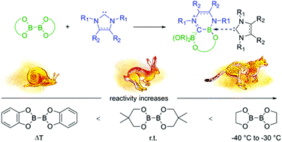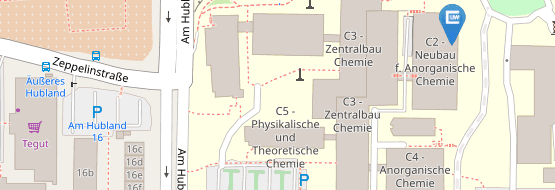Just Published in Dalton Transactions
03/20/2017B–B bond activation and NHC ring-expansion reactions of diboron(4) compounds, and accurate molecular structures of B2(NMe2)4, B2eg2, B2neop2 and B2pin2
Authors: Martin Eck, Sabrina Würtemberger-Pietsch, Antonius Eichhorn, Johannes H. J. Berthel, Rüdiger Bertermann, Ursula S. D. Paul, Heidi Schneider, Alexandra Friedrich, Christian Kleeberg,* Udo Radius,* Todd B. Marder*
Abstract: In this detailed study we report on the structures of the widely employed diboron(4) compounds bis(pinacolato)diboron (B2pin2) and bis(neopentyl glycolato)diboron (B2neop2), as well as bis(ethylene glycolato)diboron (B2eg2) and tetrakis(dimethylamino)diboron (B2(NMe2)4), and their reactivity, along with that of bis(catecholato)diboron (B2cat2) with backbone saturated and backbone unsaturared N-heterocyclic carbenes (NHCs) of different steric demand. Depending on the nature of the diboron(4) compound and the NHC used, Lewis-acid/Lewis-base adducts or NHC ring-expansion products stemming from B–B and C–N bond activation have been observed. The corresponding NHC adducts and NHC ring-expanded products were isolated and characterised via solid-state and solution NMR spectroscopy and X-ray diffraction. In general, we observed B–B bond and C–N bond activation at low temperature for B2eg2, at room temperature for B2neop2 and at higher temperature for B2cat2. The reactivity strongly depends on steric effects of the NHCs and the diboron(4) compounds, as well as on the corresponding Lewis-basicity and Lewis-acidity. Our results provide profound insight into the chemistry of these diboron(4) reagents with the nowadays ubiquitous NHCs, the stability of the corresponding NHC adducts and on B–B bond activation using Lewis-bases in general. We demonstrate that B–B bond activation may be triggered even at temperatures as low as −40 °C to −30 °C without any metal species involved. For example, the reactions of B2eg2 with sterically less demanding NHCs such as Me2ImMe and iPr2Im in solution led to the corresponding ring-expanded products at low temperatures. Furthermore, boronium [L2B(OR)2]+ and borenium [LB(OR)2]+ cations have been observed from the reaction of the bis-borate B2eg3 with the NHCs iPr2Im and Me2ImMe, which led to the conclusion that the activation of bis-borates with NHCs (or Lewis-bases in general) might be a facile and simple route to access such species.
Link: http://pubs.rsc.org/en/Content/ArticleLanding/2017/DT/C7DT00334J#!divAbstract


![[Translate to Englisch:] [Translate to Englisch:]](/fileadmin/_processed_/d/f/csm_FrontICBC2_1dbc3f66ed.jpg)
![[Translate to Englisch:] [Translate to Englisch:]](/fileadmin/_processed_/4/c/csm_IAC_Back_958d8b320b.png)

